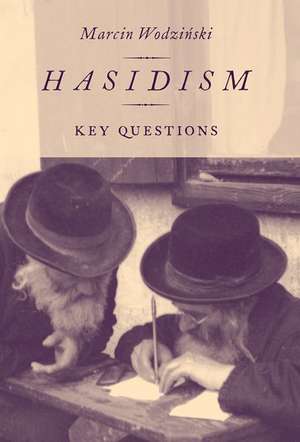Hasidism: Key Questions
Autor Marcin Wodzinskien Limba Engleză Paperback – 17 noi 2020
| Toate formatele și edițiile | Preț | Express |
|---|---|---|
| Paperback (1) | 185.41 lei 31-37 zile | |
| Oxford University Press – 17 noi 2020 | 185.41 lei 31-37 zile | |
| Hardback (1) | 513.20 lei 31-37 zile | |
| Oxford University Press – 12 iul 2018 | 513.20 lei 31-37 zile |
Preț: 185.41 lei
Preț vechi: 209.59 lei
-12% Nou
Puncte Express: 278
Preț estimativ în valută:
35.48€ • 37.14$ • 29.36£
35.48€ • 37.14$ • 29.36£
Carte tipărită la comandă
Livrare economică 25-31 martie
Preluare comenzi: 021 569.72.76
Specificații
ISBN-13: 9780197552643
ISBN-10: 0197552641
Pagini: 370
Dimensiuni: 231 x 150 x 25 mm
Greutate: 0.52 kg
Editura: Oxford University Press
Colecția OUP USA
Locul publicării:New York, United States
ISBN-10: 0197552641
Pagini: 370
Dimensiuni: 231 x 150 x 25 mm
Greutate: 0.52 kg
Editura: Oxford University Press
Colecția OUP USA
Locul publicării:New York, United States
Notă biografică
Marcin Wodzinski is Professor of Jewish History and Literature at the University of Wroclaw, Poland. His special fields of interest are Jewish material culture and the social history of Jews in nineteenth-century Eastern Europe, especially the history of Hasidism and Haskalah. His books include: Hebrew Inscriptions in Silesia 13th-18th c. (Pol., 1996), Haskalah and Hasidism (2005), Hasidism and Politics (2013), and Historical Atlas of Hasidism (2018).
Recenzii
This is an excellent and comprehensive teaching tool for Jewish studies and religion programs ... Highly recommended.
Overall, it is a work that can be read without special knowledge of Judaism. Whoever deals with the Jewish history of Central and Eastern Europe should not only read it, but read it - since it is not only methodologically innovative, but also calls for a number of new perspectives to be discussed.
A path-breaking and extremely important volume.
In Key Questions, Wodzinski presents us with a highly reflective and methodical application of the tools of social history to Hasidism, primarily in its "golden era" of the 19th century
Wodzinski asks seven questions that challenge the conventional images and notions of what Hasidism is. Drawing on a fresh behavioral perspective, an unprecedented range of sources, and established quantitative and social science methods, he fractures the 'founding stereotypes' of Hasidic scholarship, creating a whole new framework for understanding this legendary and influential religious movement.
Marcin Wodzinski is one of the most incisive scholars of Hasidism, especially in the nineteenth century. His books on Hasidism and Haskalah and on Hasidism and Politics have become essential texts. This important new volume addresses some of the key questions about Hasidism in its golden age: its definition, the role of women, the figure of the tsaddik, the Hasidic economy, and more.
Marcin Wodzinski's book insightfully addresses a series of neglected topics in Hasidism, dealing with subjects that are more mundane, concrete, and at the same time central to the daily life of the various Hasidic denominations. Unlike the more conceptually-oriented approach, which prefers to focus on spiritual life, and the historical one, which is more oriented to major events that shaped Hasidism, this book offers a fresh approach to neglected aspects such as economics, the vicissitudes of history during WWI, and the self-identity of both men and women in Hasidism.
Overall, it is a work that can be read without special knowledge of Judaism. Whoever deals with the Jewish history of Central and Eastern Europe should not only read it, but read it - since it is not only methodologically innovative, but also calls for a number of new perspectives to be discussed.
A path-breaking and extremely important volume.
In Key Questions, Wodzinski presents us with a highly reflective and methodical application of the tools of social history to Hasidism, primarily in its "golden era" of the 19th century
Wodzinski asks seven questions that challenge the conventional images and notions of what Hasidism is. Drawing on a fresh behavioral perspective, an unprecedented range of sources, and established quantitative and social science methods, he fractures the 'founding stereotypes' of Hasidic scholarship, creating a whole new framework for understanding this legendary and influential religious movement.
Marcin Wodzinski is one of the most incisive scholars of Hasidism, especially in the nineteenth century. His books on Hasidism and Haskalah and on Hasidism and Politics have become essential texts. This important new volume addresses some of the key questions about Hasidism in its golden age: its definition, the role of women, the figure of the tsaddik, the Hasidic economy, and more.
Marcin Wodzinski's book insightfully addresses a series of neglected topics in Hasidism, dealing with subjects that are more mundane, concrete, and at the same time central to the daily life of the various Hasidic denominations. Unlike the more conceptually-oriented approach, which prefers to focus on spiritual life, and the historical one, which is more oriented to major events that shaped Hasidism, this book offers a fresh approach to neglected aspects such as economics, the vicissitudes of history during WWI, and the self-identity of both men and women in Hasidism.
